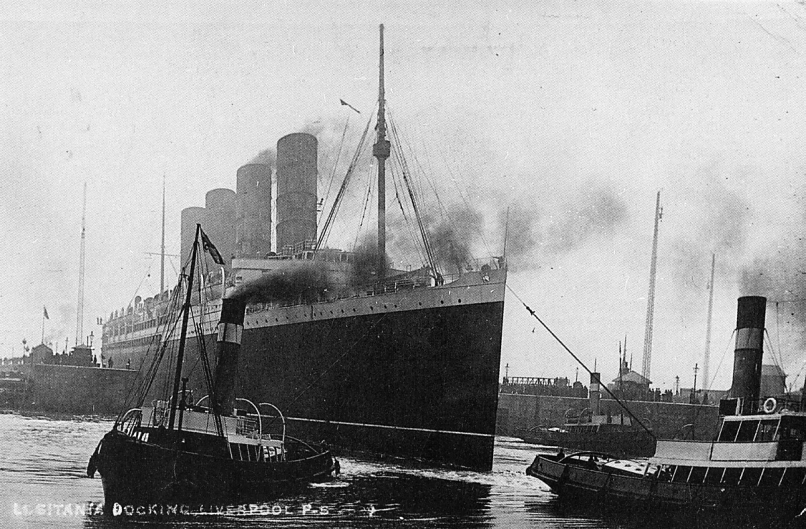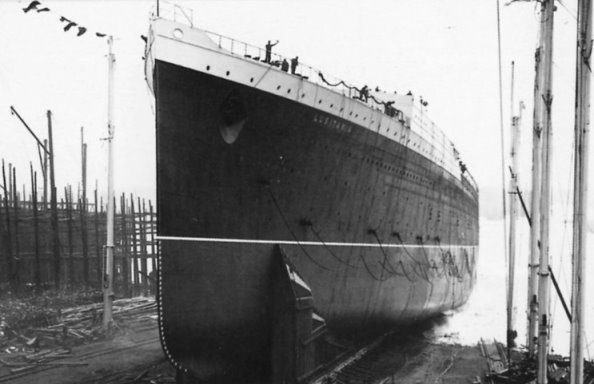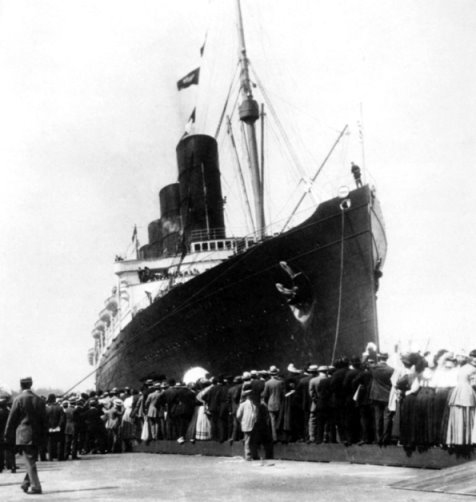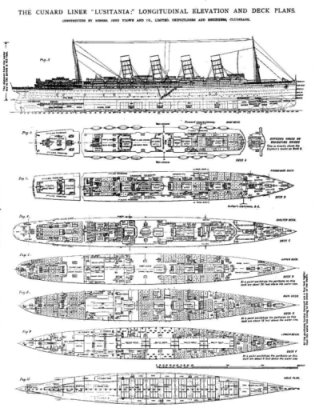RMS Lusitania (1906)
Introduction (1938)
The race was on to gain dominance of the Atlantic crossing. In the late 1890s, Norddeutscher Lloyd and the Hamburg America Line, two German shipping companies, had built fast and luxurious ships, such as the Kaiser Wilhelm der Grosse and the Deutschland, which threatened to put an end to the British dominance of the Atlantic.

In 1902, Cunard retaliated by planning the commission of two ships which would be the largest, fastest and most luxurious ever built. After serious negotiations, Cunard placed orders with John Brown & Co to build the Lusitania, and Swan Hunter & Wigham Richardson on the River Tyne to build the Mauretania.
Before construction could begin, there was the problem of finance: £2,600,000 would be needed to build them. Negotiations began between the Cunard Line and the British Government. Cunard wanted to secure a loan repayable over 20 years at low interest.
The British Government agreed provided that the ships would be built to Admiralty specifications and that they could be called into active military service whenever the need arose. This would mean that they would have to be fast, especially in active service, to avoid being easy prey from enemy submarines.
Indeed, in the spring of 1909, her three bladed propellers were replaced with four bladed ones to give her extra speed.
Lord Inverclyde discussed the Cunard Agreement with a committee of experienced engineers in September 1903, to establish what was needed to fulfil the contract.
Leonard Peskett produced the preliminary designs for the two ships and careful consideration was given to the layout of each. Most of the machinery was installed beneath the waterline. The original plans gave each ship three funnels but the final plans gave four.
Construction of RMS Lusitania
The Lusitania’s keel was laid down on 17 August 1904 under yard number 367. Her construction was divided into two sections: front and stern. This allowed the designers extra time to arrange machinery in the engine rooms. Her forward end was almost completed before the stern had started.
By the end of spring 1905, the Lusitania's double bottom was in place. The work continued, paying particular attention to the stern of the ship. As a Naval Rescue Ship, she would have to be fast as well as elegant.
Her hull weighed 16,000 tons but once fitted with her boilers, engines, panelling etc. she had a gross tonnage of 31,550. The Lusitania was 787 feet long and had a beam of 87 feet. She had 9 decks and could carry 2198 passengers: 552 First Class, 460 Second Class and 1,186 Third Class. A crew of 850 was needed for her operation.
Once completed, Britain would have the grandest ships afloat with which to regain the Blue Riband.
On 7 June 1906 at 12.30 p.m., the Lusitania was launched by Lady Mary Inverclyde, an occasion attended by 600 VIP guests. The ship took only 86 seconds to launch. Work had taken 17 months so far.

It took just under one year to fit the ship out. Hundreds of workers worked around the clock trying to keep up with the strict deadlines placed on them by the British Admiralty.
As soon as the Lusitania was completed, she left the Clyde to commence her sea trials. No record has survived relating to them but many alterations were made following the conclusion of these trials. Most of them were made to the stern section.
Maiden Voyage
The Lusitania departed from Liverpool bound for Queenstown at 9 pm on Saturday 7 September 1907. She was commanded by Commodore James Watt. A crowd of 200,000 people had gathered to see her departure. She arrived at Queenstown at 9.20 am the next day and took on passengers. BY 12.10 pm her passenger number was 2,320.
There were high hopes that Lusitania would win the Blue Riband but it was not to be. The Lusitania arrived in New York on 13 September 1907, after completing the crossing of the Atlantic in 5 days and just under two hours – thus just missing out on the Blue Ribbon, then held by the Deutschland.
It was reported by the Daily Telegraph’s New York correspondent that scores of wireless messages were received from the Lusitania and said “There is a great deal of betting in the smoke-room regarding the maximum day’s run. We can beat the Deutschland’s total of 601 miles one day if the captain gave the order but there is no racing against time.”
The Lusitania made good speed during the crossing; her greatest distance was recorded at 593 miles.
At New York, hundreds of thousands had gathered to see the arrival of the largest ship in the world. She arrived at Pier 56 and received a warm welcome.

